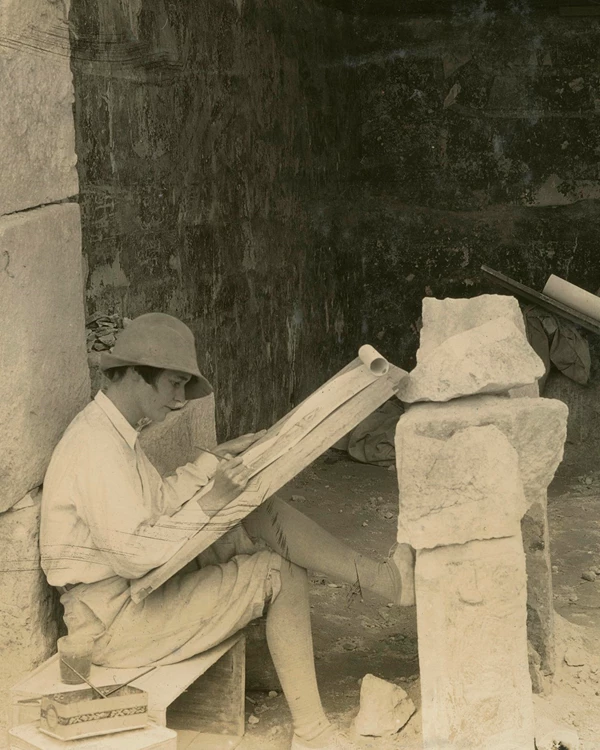Last updated: February 8, 2022
Person
Ann Axtell Morris

Peabody Museum of Archaeology and Ethnology, Harvard University, 58-34- 00/2.1347
Ann Axtell knew she wanted to study ancient cultures from the time she was six years old. It was not until much later that she quite understood what archeology was. In her words, “If there was an “ology” that told the story [of the past], and if there were “ologists” who knew anything about it, my course lay clear.”
Ann received her bachelor's degree from Smith College in 1922. After graduating, she traveled to Paris for field training with the American School of Prehistoric Research in France. Ann entered professional life as an archeologist at a time when men largely did not include women in the discipline. In 1923, Ann married Earl Halstead Morris.Though an archeologist in her own right, Ann referred to her “career of being an archeologist’s wife,” eluding to the tactic of women archeologists to navigate institutional sexism and find a place for themselves. Smith College awarded Ann an honorary master's degree in 1935.
On their honeymoon, Ann and Earl excavated Mummy Cave, now inside Canyon de Chelly National Monument in Arizona, where they hired Navajo to work on the dig. From 1923 to 1929, and again in 1932, the Morrises excavated Canyon del Muerto. Ann developed methods to document architecture, petroglyphs and pictographs, and landscapes. Ann's colorful drawings captured information that then-popular black-and-white photography would have lost. For example, while at Canyon del Muerto, she made watercolors of the cave and kiva wall paintings to “copy in full color and accurate detail as many of the hundreds of pictographs along the canyon’s gallery walls as possible.” In 1929, she illustrated the ancient art at Antelope House, Pictograph Cave, and Standing Cow Ruins. These paintings were exhibited at the American Museum. The couple worked on multiple sites during this time, including Mesa Verde in Colorado and Aztec Ruins in New Mexico.
Starting in 1924, in cooperation with the Carnegie Institute of Washington, the Morrises spent five winters excavating the Mayan city Chichén Itzá in eastern Mexico. When Ann first arrived, archeologist Sylvanus Morley told her to babysit his six-year-old daughter and act as hostess to visiting guests. Ann, instead, convinced him to allow her to excavate a small, overlooked temple. Ann also copied the Temple of the Warrior murals, which took four seasons. Her final illustrations were published in Temple of the Warriors at Chichén Itzá, Yucatan, coauthored with Earl and a French painter, Jean Charlot.
Together, Ann and Earl wrote many studies on ancient lifeways within the American Southwest and Mexico, including one on Native American sandals that their archeologist daughter Elizabeth Ann expanded upon years later. Ann herself wrote two popular books, Digging in the Southwest (which upended conventional thinking about the Anasazi people) and Digging in the Yucatan. Ann intended the books to have a popular audience, in order to educate the public about the field. The publishers, however, marketed the books to older children because they did not recognize that women could write literature about archeology for adults.
Ann and Earl Morris had two daughters, Elizabeth Ann and Sarah Lane. Elizabeth studied Anthropology at the University of Arizona, and following in her parents footsteps, became an Archaeologist and Professor at Colorado State University.
Image credit: Gift of the Carnegie Institution of Washington, 1958. © President and Fellows of Harvard College, Peabody Museum of Archaeology and Ethnology, Harvard University, 58-34-00/2.1347
Morris, Ann Axtell
1931 Digging in Yucatan. Junior Literary Guild. New York City.
1933 Digging in the Southwest. Doubleday, Doran & Co.
Sources:
Burgh, Robert F.
1957 "Earl Halstead Morris, 1889-1956." American Anthropologist, Vol. 59, Iss. 3.
Lister Florence, C. and Robert H. Lister
1993 Earl Morris & Southwest Archaeology. Western National Parks Association.
Theis, Aaron
2013 "Ann Axtell Morris: Art in Archaeology of the Southwest and Mesoamerica." Archaeological Institute of America.
